5-29-20
Papicha: By Her Own Design
By Diane Sippl
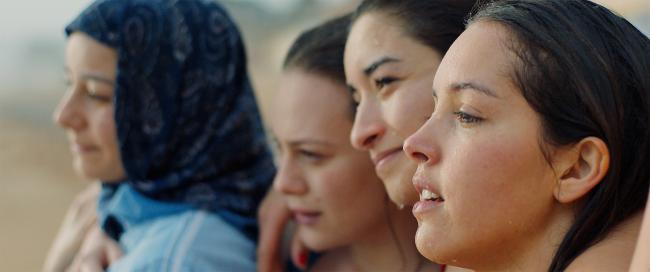
She didn’t want to run away—she loved her town, her friends, her country, her family—and at her young age, when she doesn’t know what another country is like, it’s somehow a violence to have to adapt, and she didn’t want that. She’s a heroine—that’s why she does something difficult.
Writer-Director Mounia Meddour, Papicha
The first feature film by Mounia Meddour, Papicha (translated as an attractively “hip” young lady), screened at the 2019 Cannes Film Festival in the Un Certain Regard category, and it was selected as Algeria’s official submission for the Best International Feature Film category at the 92nd Academy Awards in 2020. The film had its North American Premiere in 2019 at COLCOA French Film Festival in Los Angeles; it won French César awards for Best First Feature Film and Best Newcomer Actress (Lyna Khoudri). Papicha is currently showing at Film at Lincoln Center through Distrib Films Virtual Cinema.
The story takes us to Algeria during its Civil War in the 1990s where Nedjma is a lively university student who studies French but also enjoys going out dancing with her roommates and exploring romance with a young man. Yet more than anything, Nedjma lives and breathes to design dresses, and she even sells them to acquaintances at the discotheques. Visual self-expression is everything for this dauntless young student on the brink of her career and her future. Meddour shows us the support she compels from her girlfriends, her sister, her mother, and ultimately, her female professor, who possesses a circumspect wisdom Nedjma is fearless to challenge. Papicha demonstrates a lyrical realism that is sure to place Meddour in high relief on the map of world cinema.
Precursors come to mind for various aspects of this film. For example, Battle of Algiers was newly restored in 2016 for its 50th anniversary as Meddour was writing and seeking funding for Papicha. Pontecorvo’s film is celebrated for applying the tenets of neorealism through its location shooting of a largely lay cast with a hand-held camera to bring a documentary feel to a fictional re-enactment of the country’s war for independence. Yet its tight focus on the Front de Libération Nationale as a united force against French occupation may have restricted the authenticity the film sought to capture as it showcased a monolithic vision of the country, what one critic called the official FLN position regarding the national identity: “Islam is our religion, Arabic is our language, Algeria is our fatherland.”
Far from the backstreets and alleys of the Casbah in Algiers (as depicted in the film), most of the revolution was fought in the mountains and countryside, and between 1954 and 1962, many factions were driven into consolidation with the FLN. Among them were women, and it was Franz Fanon, then living in Algeria, who noted that in 1956-57, educated, middle-class women were participating in this one urban moment of a revolution that was primarily rural. Both in deploying the veil as a means for concealing weapons and in casting it off to appear seductively French while they planted bombs in cafes, women used the veil in its presence or absence as a tactic of guerilla warfare. One way or another, they used their agency to fight for liberation.
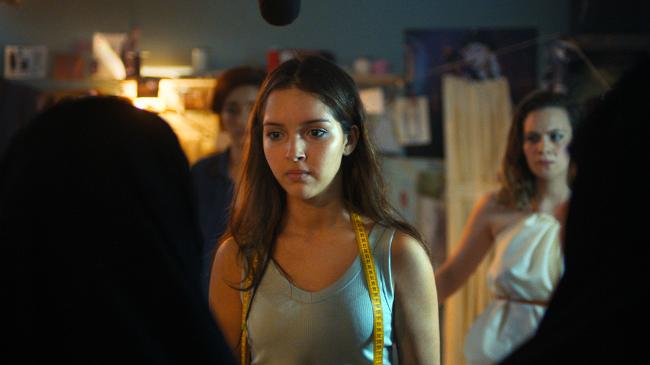
Yet perhaps there is a far less obvious inspiration, whether conscious or unconscious, for the core value of Papicha, that of deliberate self-expression through the female body—its visibility, its consciousness, its autonomous decision-making. Such overt choices as how one dresses convey both tangible and symbolic meanings, sometimes as direct demonstration and sometimes as parody (or even just irony) in another realm of public discourse whose terms can testify in support or negation of regimes beyond nation, culture, and ethnicity. The agency of the body as a vehicle for expression can be highly political in a way Pontecorvo might not have imagined, but Fellini did. In Roma he staged a fashion show like no other, parading the attire of priests, bishops, and cardinals, sometimes an almost literal rendering of their “costumes” if not a satire of the Roman Catholic church in its centuries of money “in-vested” in this visual hierarchy of power and extravagance. In Roma Fellini, lifting the vestments directly from life for models who strut the civil authority of the clothing’s religious significance, posits the relation between Fascism and Catholicism in Italy. In the context of this scene in his film, the hyper-expressive attire floats past us in a bizarre reality that feels surreal, one of which Fellini was a master.
It doesn’t take a master to exoticize women for their clothing (or lack of it), supposedly the flip side of the religious intentions of the veil and all its derivatives. Yet some designers of fashion have been highly celebrated for de-secularizing and even subverting traditional gendered clothing. Take Yves Saint-Laurent, in fact Algerian-born-and-raised, who grew up drafting and sewing dresses for his mother and sister in their French family in Oran. Creating with a palette and patterns often inspired by Algerian and Moroccan landscapes and insisting on models from Africa, the Middle East, and other non-western regions (the famous Mounia among them), he brought a new look to the runway and the magazine cover after his days at Christian Dior’s house of fashion. His tuxedo suit, for example, threw the prescribed gender dressing of the mid-1960s into a tizzy. “Le Smoking,” as he called his design for women’s evening attire, signaled his belief that women should feel empowered in what they wore, and it threatened fashion moguls with gender fluidity.
In fact, being drafted as a young man to fight on the side of the French in the Algerian Revolution threw Saint Laurent’s whole life off-balance, it is claimed in film after film about his career (no less than five feature-length films in a decade). Privately, he may in most ways have been the antithesis of the energetically demonstrative protagonist of Papicha, Nedjma, and yet his designing of women’s attire as a life’s passion and work (not simply his haute couture and prêt-à-porter artistic and financial successes) have been touted world-wide in both theatrical and documentary cinema, such that it is surprising to find film critics utterly overlooking the key motivation of Nedjima in Mounia Meddour’s Papicha. She studies French at the University, but her heart-and-soul aspiration (and every waking minute she can pour into it) is to design clothing. Her relentlessly prepared and defiantly staged “fashion show” is the climax of the film, so often dismissed in favor of following the violence of the Islamist extremists in the script.
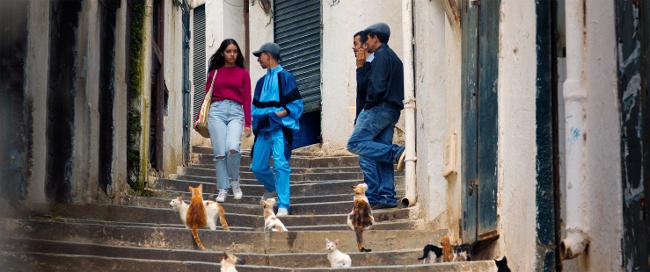
The veil... has no depth but is woven with multiple strands of meanings. Modesty, chastity, protection from sexual harassment, and conviction combine to obscure the purpose of the veil: the empowerment of a man over a woman in the intimacy of their sexual identity as borne by their bodies.
Questioning the Veil: Open Letters to Muslim Women
Marnia Lazreg, 2009
Nedjima’s fashion show sparkles in its many facets. Humble and resourceful in its means, it is inventive and artful, new and daring; it addresses diverse uses of clothing, accommodates various body types, and imagines multiple creative styles all within the limitation of a singular piece of cloth, the “haïk,” a traditional white outer garment found in every local home that was the symbol of the national Algerian resistance against French colonial policy. It disguised the weapons women carried in the War for Independence, and therefore it constituted their agency. Nedjma’s fashion show is a spectacle to marvel; it’s a playful turn of the radical conservative Islamic tide at hand in the 1990s.
A veil often draws attention to what it hides. The very ambivalence of any “sacred” or “professed” meaning of veils, abayas, hijabs, niqabs or burkas, headscarves, hoods, masks, and masquerades is one that often anchors the signification of the garment but that can also stand that signification on its head; the presence/absence ambivalence easily lends itself to subversion. Hoods, for example, range from those worn by Christian monks to those worn by the Ku Klux Klan to those pulled over the heads of criminals, either as they rob or loot or as they face execution. Masked balls, Fasching and Carnival celebrations, and Mardi Gras/Shrovetide rituals have crossed through syncretism from “pagan” practices to Catholic feast days to secular dances and holidays. Is this process of inscription of values—religious, cultural, political, ideological—such a manageable vehicle for expression? Historically, men have sought to control women’s dress as a means to control women, revealing not so much the state of feminine identity as that of masculine identity, of their own insecure, unstable ability to decree power by force.
The early 1990s brought a climate of political extremism to Algeria that would come to be known as the “Black Decade,” in which more than 150,000 people died in the country’s Civil War. In the name of religion, women were forbidden to go to work or to attend the university, and some were assassinated for refusing to wear the veil. Groups that coerced women to wear veils also persecuted them for working as hairdressers or practicing divination arts. According to Algerian scholar Marnia Lazreg, some women were also forced into “temporary marriage,” a custom imported into Algeria then from Shi’i Islam practices that allowed for raping women with impunity. Lazreg writes, “Clearly not all parties engaged in a war against the Algerian state condoned this practice. Nevertheless, by focusing on women as embodiments of the ills of ‘Western’ culture, they set the tone for the mistreatment of women. No warring group (including the state army or police) issued a statement condemning the practice or recommending that women be left out of the battle raging between men.”
Certainly the ‘West’ has played a role in Algeria’s history and in exacerbating radically conservative politics in the Middle East. Yet what had women to do with the imperialism of the West over the East except to become subject to the veil? In the “Black Decade,” the veil was used as a banner separating East and West, Islam and Christianity, piety and immorality when in reality it served as a tent pole for masculine identity. Marnia Lazreg spells it out:
No country in the Muslim world would be in danger of cultural extinction if all women were to jettison the veil. But it would mean that male advocates of veiling would have to make adjustments to their perception of themselves. They would have to understand that they are no less men for accepting women as their social equals—for accepting that a woman’s body is hers to live, not a man’s prerogative to regulate in its most minute details of grooming, dressing, and (most important) experiencing.
But Lazreg’s analysis doesn’t stop here, and neither does Meddour’s. The scholar’s observation applies to the filmmaker’s premise. Lazreg argues, “Conversely, a woman would have to ask herself why she looks on as a man arrogates to himself the right to advocate for the veil, speak in the name of God, and use persuasion or coercion to keep a woman in line with his conception of her body.” Some women actively took up force in behalf of “God and country” (i.e.—men) to subject other women to the veil during the Civil War. Violence, bombs, and attacks ensued as the everyday norm; everyone knew someone who had been killed, and for the public, the received images of Algeria were of victims, casualties of the war. Most people didn’t know what was going on at the time, the way women resisted the insurgent regime. Yet women were always there, to hold the society together and sustain the country’s energy but also to fight the new rules being imposed. In pursuit of emancipation, Papicha’s heroine, Nedjma, continues to study and live her life despite the danger. In making her film, Mounia Meddour takes us right into the middle of the chaos, right to the front line of women’s battle against their oppression, to show us their problems, the difficulties of holding onto their dreams.
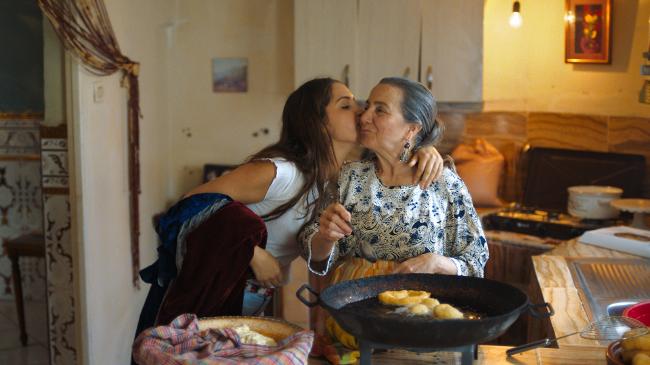
During one year in the Civil War when she couldn’t go to school, Mounia Meddour remained at home to design and sew clothes that she sold at a shop in her neighborhood. It was a small enough town for her to see women wearing her styles as she walked down the street. However, there was a masculine and a feminine side to fashion, and in general, men dominated the public space, and women’s place was the private space. Therefore, for Meddour’s character of Nedjma, a working-class student, the university is a thrill, a space of freedom away from home. She is fragile at first because she’s young, but she develops strength. Her friends are diverse: Kahina would like to emigrate to Canada, given the chance, and while Wassila’s emotions are tender for love, Samira’s are firmly devout. The young men they meet are attractive and live comfortably, but they are demanding and difficult. The girls turn to each other for solace. Their incredible ingenuity and resilience allows then to avoid the mandated hijab. Yet beyond the vitality and intimacy of their connection as roommates, girlfriends, and confidantes, Meddour captures the authenticity of their atmosphere.
It’s important for this writer-director to apply her acumen as a documentarian to portray the reality of the experience because in Nedjma, Meddour is calling upon her own past. She chose to cast not familiar faces but first-time actors (except for Lyna Khoudri, who plays Nedjma, but it is her first feature film). Khoudri’s father was a journalist and had to flee from Algeria with his family in the 1990s, not unlike Meddour’s father, who was a filmmaker, and who also took his daughter to France into exile, where she had to build a new life “overnight.” So while Khoudri intuitively understood the role, Meddour worked on adapting the film to the styles of expression of the other actors, sometimes using improvisation that yielded a very natural characterization and dramatization. In a country with no infrastructure for filmmaking, she shot her film in five weeks. The project was complicated due to its status as international co-production by France, Algeria, Belgium, and Qatar.
What follows are writer-director Mounia Meddour’s own words, excerpts from a discussion with the audience when her film screened in September of 2019 for COLCOA French Film Festival in Los Angeles. Papicha was warmly received by a packed house, and the questions spilled over into the lobby at the Directors Guild of America following the screening.
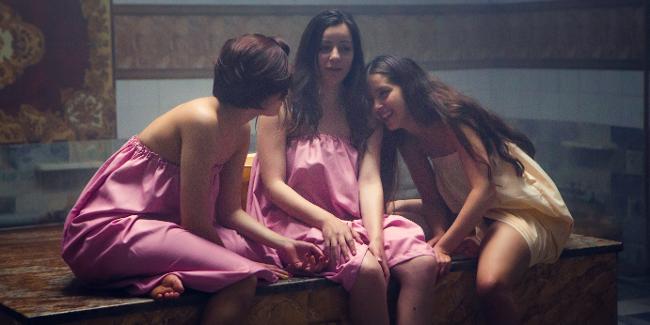
“I lived in Algeria during the 1990s, in a community similar to the one you see in the film. I was a student of Journalism and I had a radio show. I took this little university town as a microcosm of Algeria at the time, with students who were extremely varied from one to the other. Some were concentrating on their studies and some were only dreaming of leaving Algeria. What is really based on fact is this context of the university and the Civil War that was mounting, with oppression that had to do with women’s bodies. That’s how I arrived at this leading lady who uses her body as a symbol of freedom.
I cast all these girls on the Internet, on Facebook and Instagram. Movies were hardly being made in Algeria—only one or two a year—so there was no agency for the casting of actors or for directors. The one who plays Samira is a slammer (a rapper) and Kahina, the one who wants to go to Canada, has a Doctorate in Biology—she’s not an actress, really. None of the girls are professional actresses except Lyna Khoudri. She is lives in Paris and she made a lot of short movies, but this is her first feature with this main role.
I directed this movie in five weeks—which is very, very short—six days per week, and I worked a lot on the script, like five years, which was very, very long. When we arrived in Algiers we tried it in different rehearsals, and after that we re-wrote the script again and again and again, and we shot this. But stemming from my work on documentaries, and my technique is to catch the reality and the authenticity of the human being. There are a lot of moments in the film that were not in the script.
Yet the script has a lot of details. When we’re in rehearsal, I speak a lot with the actors, and with my DOP, too, because this is part of our life, and we are all very close. We have a lot of rehearsals, and after that, I let the actors play a very long time, to catch each moment. As in a documentary, they are very free. Everything was very free in this movie—the shooting, the editing, and the acting, too, because when you are a scriptwriter you can create characters for the actors, but everyone has his or her own personality, and I catch everything interesting in each of them. And afterwards, I use that for the movie. I have directed a lot of documentaries, and for this movie, my first theatrical movie, it was very important to shoot in Algiers, a place that I know, and at the university—it was my university when I was young, and the streets in Algiers were the ones I knew.
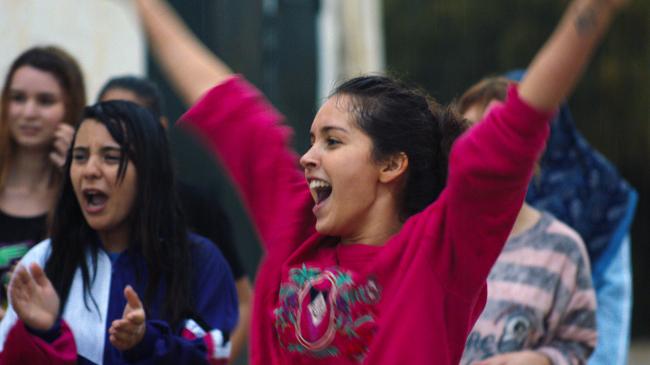
With my DP, I prepared everything before the shoot, because five weeks is so short, and the actors were making their first movie. We worked with a lot with visual references, with photos and movies. The first step was that our film was from the point of view of Nedjma, and we needed to stick with that decision from the beginning to the end. That was our first rule. We forbade all the establishing shots.
We followed Nedjma close-up with the camera because the story needs that. The movie is about her version of life. We wanted to keep our finger on the pulse, the life force, of this woman. That’s why everything is very quick, you know, dynamic, organic, something very special—this mirrors the situation at that time, because we didn’t know if there would be another attack—then we would leave everything in the same time to take advantage of the moment. At the beginning Nedjma is very young, very superficial, and after that there’s a turning point when her sister is killed, and we arrive in the second part of the film with something less dynamic and more organic.
In the 1990s we had a lot of women who actually sided with the radical faction, and they were taking advantage of this moment to spread propaganda. So there really were interruptions of our classes and also violations of our privacy, because these women would go inside the bedrooms and the private quarters of the girls. The film is not so much against the politics of Algeria as it is against the radicalism of the time. Papicha focuses on women desiring their emancipation and a very dark period of repression against that. At that time in Algiers, if you had a sister or someone from your family who was a journalist or an intellectual, you knew that she would be shot, because it was very, very dangerous. She was the first target: intellectuals, journalists, filmmakers, artists, and foreigners were the first to be killed.
The Civil War is a very taboo topic now, and most people don’t even talk about it. The fact that we were bringing up this period made people very curious, and they all came to us and shared their own personal stories as a kind of catharsis or therapy. This period was in the 1990s and it ended in 2002, and most of the radicals were killed or sent to prison. Of course, right now, everyone is in the streets, and we need to re-visit the past to make sure we don’t fall into the very same trap.
It took three years to get funding in Algeria because they change the Ministry of Culture all the time, and we tried again and again and again. Three times at the Film Commission—and after that, they said, ‘Okay, you can go. Thank you. Go.’
In the end, there’s hope—the hope that’s manifesting itself right now in Algeria with all the youths in the streets and what we call the Smiling Revolution. This film was financed by Algeria, but right now the tension is incredible, and it’s the reason that we can’t get Papicha released there. But I have two new projects. The first one is about a dancer. She’s handicapped, and she’s mute, and it’s about today, how such a person pursues her dreams. This is very interesting for me, because I like to look at the position of the woman and the way she finds her emancipation. My second idea is an adaptation of a French book, and I can’t say which one—it’s like a crime of passion, by the woman.”
Papicha
Director: Mounia Meddour; Producers: Xavier Gens, Patrick André, Grégoire Gensollen, Belkacem Hadjadj, Mounia Meddour; Screenplay: Mounia Meddour, in association with Fadette Drouard; Cinematographer: Léo Lefèvre; Editor: Damien Keyeux; Sound: Guilhem Donzel; Set Design: Chloé Cambournac; Music: Rob; Costumes: Catherine Cosme.
Cast: Lyna Khoudri, Shirine Boutella, Amira Hilda Douaouda, Zahra Doumandji, Yasin Houicha, Nadia Kaci, Meryem Medjkane, Marwan Zeghbib, Samir El Hakim.
Color, widescreen, 106 min. Arabic and French with English subtitles.